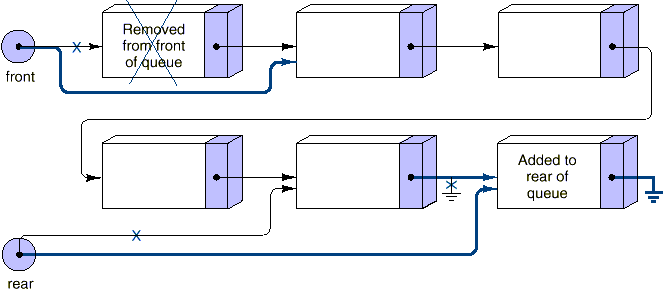Review of Queue ADT
Objectives of this lecture
q Review the Queue ADT &
Its Implementation
Review
q Recall that Queue is another data structure
which has two ends, front and rear, where data is added only
at the rear and is removed only at the front.
Thus the first item to be inserted is always the first to be removed (FIFO)
q It has so many applications,
perhaps even more than stack since first-come first serve (FCFS) is the natural way
handling competing clients. For
example, access to network resources such as printing, mail-server, web-server,
etc are mostly based on FCFS.
q Its basic operations are: CreateQueue, ClearQueue, FullQueue, EmptyQueue, AppendQueue
(enqueue) and Serve (dequeue or remove).
q It can also be implemented
using both array (static approach)and linked list (Dynamic approach).
q Recall that the array
implementation is particularly difficult because it was necessary to treat the
array as circular and the extreme cases of full queue and empty queue caused some difficulties
which had to be resolved.
Exercise: Study the implementation of queue using array in chapter four (section
3) of your book. Identify the drawbacks
of this approach.
Dynamic Implementation of Stack.
q We
recall that in this implementation, a queue consist of a linked list with two
pointers, front (pointing to the front node) and rear (pointing to the rear
node)
q It is important to ensure
that the changing implementation approach does not affect the users of your
ADT. Thus, unlike what is in the book,
we shall do the implementation such that our functions are compatible to those
in the array implementation.
q To add a new node, we simply
create a node, point the next of the current rear node to it and update the
rear pointer to points to this new node.
q To remove a node, we set the
next of the current front node to be the front pointer and free the current
front node.
q The following figure illustrates how stack is just a pointer pointing to the top node.
q
q
User interface:
/* file name: queue.h */
#include
“common.h”
typedef
…. QueueEntry; //datatype for the items
in the queue
typedef
struct queuenode { QueueEntry info;
struct queuenode *next;
} QueueNode;
typedef
struct queue { QueueNode *front;
QueueNode *rear;
}
Queue;
void CreateQueue(Queue *q);
void ClearQueue(Queue *q);
void Append(QueueEntry newitem, Queue *q);
void Serve(QueueEntry *frontitem, Queue *q);
Boolean
QueueEmpty(Queue *q);
Boolean
QueueFull(Queue *q);
Implementation Details:
//file
name: queue.c
#include
“queue.h”
QueueNode
*MakeNode(QueueEntry item);
/*
CreateQueue: create the queue.
Pre: None.
Post:
The queue q has been initialized to be empty.
*/
void
CreateQueue(Queue *q)
{ q->front = q->rear = NULL;
}
/*
AppendNode: append an entry to the
queue.
Pre: newitem is a valid queue entry
Post:
new node is created, the new item has been placed in the
new node and rear points to the new node. If this is the first
node, front
also points to it
Uses:
QueueEmpty, MakeNode, Error. */
void Append(QueueEntry newitem, Queue *q)
{
QueueNode *p = MakeNode(newitem);
if (p != NULL)
Error("Attempt to append a
nonexistent node to the queue.");
else if (QueueEmpty(q)) /* Set both front
and rear to p. */
q->front = q->rear = p;
else {
q->rear->next = p;
q->rear = p;
}
}
/*
ServeNode: remove the first entry in
the queue.
Pre: The linked queue q has been created and is
not empty.
Post:
The first node in the queue has been removed and parameter
p points to this node.
Uses:
QueueEmpty, Error.
*/
void Serve(QueueEntry *frontitem, Queue *q)
{ QueueNode *p;
if (QueueEmpty(q))
Error("Attempt to delete a node
from an empty queue.");
else {
p = q->front;
q->front =
q->front->next;
if (QueueEmpty(q)) /* Is the queue now empty? */
q->rear = NULL;
*frontitem =p->info;
free(p);
}
}
/*
MakeNode: make a new node and insert item.
Pre: None.
Post:
Create a new node and insert item in it.
*/
QueueNode
*MakeNode(QueueEntry item)
{ QueueNode *nodepointer;
nodepointer = (QueueNode *)
malloc(sizeof(QueueNode));
if (nodepointer == NULL)
Error("Exhausted memory.");
else
{
nodepointer->info = item;
nodepointer->next = NULL;
}
return nodepointer;
}
Exercises:
q Implements the remaining
functions: (E2: page 164)
ClearQueue,
QueueEmpty, QueueFull
